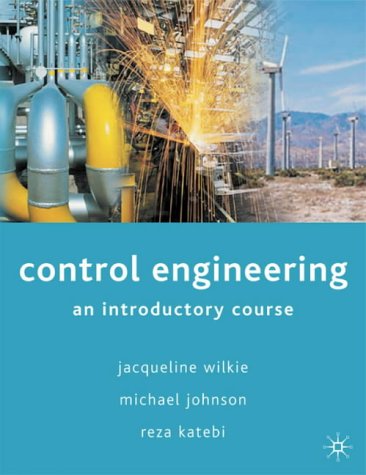

Most ebook files are in PDF format, so you can easily read them using various software such as Foxit Reader or directly on the Google Chrome browser.
Some ebook files are released by publishers in other formats such as .awz, .mobi, .epub, .fb2, etc. You may need to install specific software to read these formats on mobile/PC, such as Calibre.
Please read the tutorial at this link: https://ebookbell.com/faq
We offer FREE conversion to the popular formats you request; however, this may take some time. Therefore, right after payment, please email us, and we will try to provide the service as quickly as possible.
For some exceptional file formats or broken links (if any), please refrain from opening any disputes. Instead, email us first, and we will try to assist within a maximum of 6 hours.
EbookBell Team

4.1
20 reviews
ISBN 10: 033377129X
ISBN 13: 9780333771297
Author: Jacqueline Wilkie
Control Engineering ""An Introductory Course"" is aimed at second or third year courses in Electrical and Mechanical Engineering, and provides for the needs of these courses without being over-burdened with detail.
The authors work in one of the foremost centres in Europe for Control Engineering, and bring both teaching and practical consultancy experience to the text, which links theoretical approaches to actual case histories. Including an introduction to the software tools of MATLAB and SIMULINK, this book also includes simulations and examples throughout, and will give a straightforward and no-nonsense introduction to Control Engineering for students, and those wishing to refresh their knowledge.
Chapter 1: Tools for the Control Engineer
How many ways of writing complex numbers are there?
What is the complex exponential and how do I use it?
I just want to know how to add, subtract, multiply and divide complex numbers. Is this easy?
Control engineers talk about transfer functions. What is a transfer function?
What are the magnitude or gain values of a complex number?
How do I work out the phase of a complex number?
Chapter 2: Software Toolkit: MATLAB
Introduction to MATLAB
Basic MATLAB commands and functions
Working with matrices and arrays
Plotting and visualization in MATLAB
Solving equations and simulations
Chapter 3: Software Toolkit: Simulink
Introduction to Simulink
Building models in Simulink
Simulating dynamic systems
Analyzing simulation results
Integrating MATLAB and Simulink
Chapter 4: Modelling for Control Engineering
Physical systems and mathematical models
Transfer functions and block diagrams
State-space representations
Linearization of nonlinear systems
Modelling examples from various engineering disciplines
Chapter 5: Simple Systems: First-Order Behaviour
Characteristics of first-order systems
Time response analysis
Steady-state and transient responses
Examples and applications
Chapter 6: Simple Systems: Second-Order Systems
Characteristics of second-order systems
Damping and natural frequency
Time response analysis
Examples and applications
Chapter 7: Feedback Improves System Performance
Concept of feedback in control systems
Positive and negative feedback
Effects on system stability and performance
Examples and applications
Chapter 8: Design Specifications on System Time Response
Setting performance criteria
Time domain specifications
Designing for desired response
Examples and applications
Chapter 9: Poles, Zeros, and System Stability
Understanding poles and zeros
Stability criteria
Root locus analysis
Examples and applications
Chapter 10: Three-Term Control: PID Control
Introduction to PID control
Proportional, Integral, and Derivative actions
Tuning PID controllers
Examples and applications
Chapter 11: PID Control: The Background to Simple Tuning Methods
Ziegler-Nichols method
Cohen-Coon method
Trial and error tuning
Examples and applications
Chapter 12: Root Locus for Analysis and Design
Concept of root locus
Sketching root loci
Stability analysis using root locus
Examples and applications
Chapter 13: The Frequency Domain
Frequency response analysis
Bode plots
Nyquist plots
Stability analysis in the frequency domain
Chapter 14: Frequency Response Using Bode Plot Presentation
Constructing Bode plots
Interpreting Bode plots
Designing controllers using Bode plots
Examples and applications
Chapter 15: Controller Design Using the Bode Plot
Lead and lag compensators
PID controller design
Frequency domain design techniques
Examples and applications
Chapter 16: Analysis and Simple Design Using the Nichols Chart
Introduction to the Nichols chart
Plotting open-loop frequency response
Determining closed-loop performance
Examples and applications
Chapter 17: Practical Aspects of PID Control
Implementation of PID controllers
Practical considerations and limitations
Examples and applications
Chapter 18: PID Controller Tuning Methods
Tuning methods overview
Practical tuning techniques
Examples and applications
Chapter 19: Introducing a State Variable Description of a System
State-space representation
State variables and matrices
Converting transfer functions to state-space
Chapter 20: Linearisation of Systems from the Non-linear World
Linearization techniques
Small signal analysis
Examples and applications
Chapter 21: Analysis of State Variable Systems
Solving state equations
Stability analysis in state-space
Controllability and observability
Chapter 22: An Introduction to Control Using State Variable System Models
State feedback control
Pole placement
Observer design
control engineering degree
introduction to control engineering
automation and control engineering course
advanced control engineering
control engineering basics pdf
b.s. in automation and controls engineering technology course curriculum
Tags: Jacqueline Wilkie, Engineering, Introductory